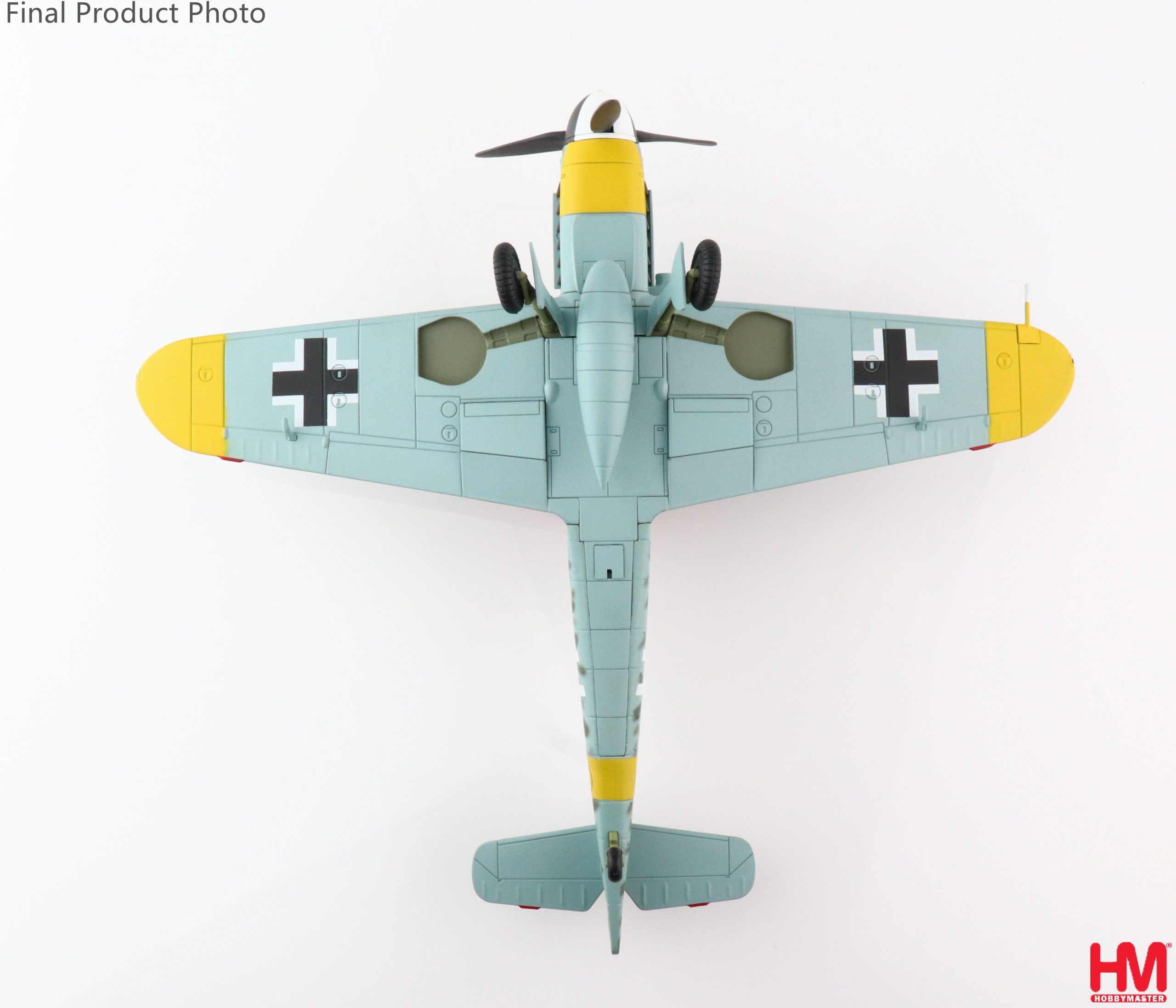Messerschmitt Bf 109G – 9./JG 52, Erich Hartmann, Luftwaffe, October 1943 1/48
Add to compare1 in stock
£90.00
1 in stock
Hobby Master 1/48 scale HA8755: Messerschmitt Bf 109G of 9./JG 52, Erich Hartmann, Luftwaffe, October 1943
Length 7.5 inches Wingspan 8.25 inches
Erich Alfred “Bubi” Hartmann was a German fighter pilot during World War II and the most successful fighter ace in the history of aerial warfare. He flew 1,404 combat missions and participated in aerial combat on 825 separate occasions. He was credited with shooting down a total of 352 Allied aircraft, Those being 345 Soviet planes and seven American while serving with the Luftwaffe. During the course of his career, Hartmann was forced to crash-land his fighter 16 times due to either damage received from parts of enemy aircraft he had just shot down or mechanical failure.
Hartmann, a pre-war glider pilot, joined the Luftwaffe in 1940 and completed his fighter pilot training in 1942. He was posted to the veteran Jagdgeschwader 52 (JG 52) on the Eastern Front and was fortunate to be placed under the supervision of some of the Luftwaffes most experienced fighter pilots. Under their guidance, Hartmann steadily developed his tactics.
On 29 October 1943 he was awarded the Knights Cross of the Iron Cross for 148 enemy aircraft destroyed. On January 30, 1944 Erich Hartmann claimed six enemy aircraft; his 178th – 183rd victories and on February 1, 1944 he claimed another five victories; his 186th – 190th. On February 26, 1944 10 Airacobras fell victim to Hartmann. As his reputation developed he gained the nickname Cherniy Chort (“Black Devil”), both because of his skill and his aircraft’s paint scheme. He was awarded the Oak Leaves to the Knights Cross for 202 enemy aircraft on 2 March 1944, followed by the Swords to the Knights Cross with Oak Leaves exactly four months later for 268 enemy aircraft shot down. Ultimately, Hartmann earned the coveted Knights Cross of the Iron Cross with Oak Leaves, Swords and Diamonds on 25 August 1944 for claiming 301 aerial victories. At the time of its presentation to Hartmann, this was Germany’s highest military decoration.
On October 1, 1944 he was appointed Staffelkapitan of 4./JG 52 (or 7./JG 52) based in Hungary and by the end of December that year he had a total of 331 victories.
Hartmann achieved his 352nd and last aerial victory at midday on 8 May 1945, hours before the German surrender. Along with the remainder of JG 52, he surrendered to United States Army forces and was turned over to the Red Army. In an attempt to pressure him into service with the Soviet-friendly East German National People’s Army he was tried on war crimes charges and convicted. He was initially sentenced to 20 years of imprisonment, later increased to 25 years, and spent 10 years in various Soviet prison camps and gulags until he was released in 1955. In 1997, the Russian Federation (posthumously) relieved him of all charges.
Hartmann was in the early cohort of German pilots who got exhaustive training before they were sent to the Front. The Germans couldn’t sustain this through the war, but it was crucial early on. He knew his plane, mission, and tactics extremely well. Pilot training is almost always the dominant factor in an air battle.
He also had a dogfighting strategy that was a great match for his situation on the Eastern Front. It was more of an anti-dogfighting strategy, really. Hartmann always sought quick, surprise attacks and avoided twisting-and-turning engagements that would have made him more vulnerable. This is exactly as it should have been, since he usually had free-hunt missions, a choice of targets, and the luxury of deciding when, and if, to engage.
Hartmann is well known for striking at very close range. This made his gunfire lethal, saved ammo for more enemies, and didn’t alert his targets before absolutely necessary. A lot of his victims never knew anyone was there until one of their wings ripped off or their engine blew up. Hartmann essentially shot himself down a few times by running into his enemy’s shrapnel; a true indication of just how close he liked to get.
In 1956, Hartmann joined the newly established West German Air Force in the Bundeswehr, and became the first Geschwaderkommodore of Jagdgeschwader 71 “Richthofen”. He was retired in 1970, due to his opposition to the procurement of the F-104 Starfighter. In his later years, after his military career had ended, he became a civilian flight instructor. Erich Hartmann died on 20 September 1993 aged 71.
Designed to meet a Luftwaffe need for a single-seat fighter/interceptor, the Messerschmitt Bf 109 was first flown on May 28th, 1935. Its all-metal construction, closed canopy and retractable gear made the Bf 109 one of the first true modern fighters of WWII. This versatile aircraft served in many roles and was the most produced aircraft of the war and the backbone of the Luftwaffe, and was flown by Germanys top three aces, who claimed a total of 928 victories between them. Armed with two cannons and two machine guns, the Bf 109s design underwent constant revisions, which allowed it to remain competitive until the end of the war.
The Bf 109G was the most numerous version of this long-lived German fighter. Around 10,000 were produced in ten main variants. The 109G was used by every German day fighter unit, and by eight other countries. Ironically, this version of the Bf 109 was not meant to exist. It had originally been hoped that the 109F would be replaced by an entirely new fighter. The Me 209 had first flown early in 1939, but it was soon discovered to offer little or no improvement over the 109F, and at quite a considerable increase in complexity. Work began in 1941 on the Me 309, another failed attempt to produce a replacement 109. The only other successful German single seat fighter of the war, the Fw 190, was good at low level, but poor at high altitude. By 1941 the air war was moving to increasingly high altitudes, and so in the summer of 1941 the Messerschmitt design team began work on yet another version of the 109; the G (Gustav)
The 109G was designed around the DB 605 engine. This was heavier than the engines it replaced, but the same size, so could fit in the same fuselage designs. It produced a fighter that was heavier than the 109F, but faster. The new machine was also less manoeuvrable than the 109F, which was preferred by many of the fighter experts. The engine also caused two major problems. First, early versions were prone to engine fires caused by overheating oil. This was soon fixed. Second, the engine type suffered from low oil pressure. This second problem was never satisfactorily fixed.
The Bf109 was obsolescent towards the end of World War Two, yet it remained the backbone of the German Air Forces day fighter force and was flown by many of her allies. In production right up to the end of hostilities, more than 33000 were built; second only to the Russian ‘Sturmovik’ as the most prolific military design, and post-war versions served with the Czech, Israeli and Spanish Air Forces, the latter until the mid-1960s with Rolls Royce Merlin engines; Some of these surviving long enough to be used in the classic ‘Battle of Britain’ film in 1968.
| Weight | 1.4 kg |
|---|







